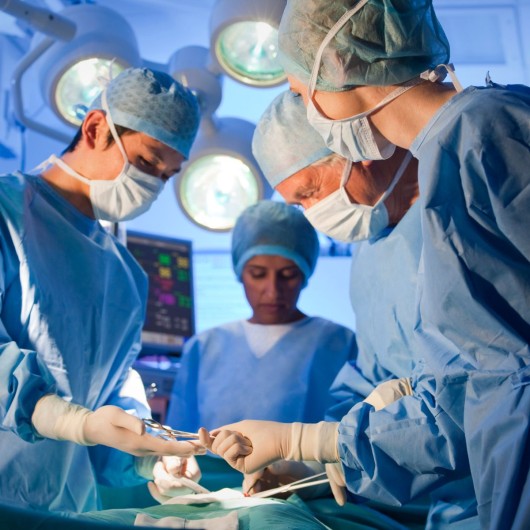
Robotic Hysterectomy (for cervical neoplasia)
- Hospital stay: 5 days
- Surgery time: 60 - 80 min.
- Anaesthesia: General
- Surgical approach: Robotic-assisted surgery
- Full recovery: 5 - 6 weeks
Fixed price
22.600 €
All included
Consult financing conditions
Financing is available* for amounts over €150, and can be financed from 3 and to 24 months. The financing process is subject to approval by the collaborating financial entities. For further information on the financing conditions, please do not hesitate to contact us at +34 91 141 33 56 or through this contact form. Our Patient Service department will provide you with the information you need and explain the financing process. Find additional information about funding in the following link. *Operarme’s team manages the funding of surgical procedures and medical tests. The financing management of dental services is only performed at Caser Dental Clinics.
What do our patients think?
What is included?
-
Free surgical consultation
Request a free, immediate surgical assessment consultation with the Robotic Surgery Team.
Meet the specialist, assess your personal case with him, and together decide on the best treatment option for you.
-
Pre-operation study
A complete pre-operation study will be performed: including a blood analysis, electrocardiogram and chest-X rays.
Also a consultation with the Anaesthetist will be held to see if you are suitable for the surgery.
-
Surgical procedure expenses and fees
- Reservation and booking of the operation room, instruments, equipment,consumables and medication of the surgical procedure. Medication (non cytostatic nor monoclonal antibody or derivatives), medical gases,
- Stay in the postoperative recovery room, monitorization and necesary treatments, Pathological anatomy, haemotherapy-blood transfusions.
- Surgeon, assistant and anaesthetist fees until your medical discharge.
-
Hospital stay
The length of stay is 5 days in one of the Suite-type rooms at the private hospitals, with the option to add a spare bed for a companion.
-
Robotic-assisted surgery (da Vinci Robot)
The price includes the use of surgical instruments, operating room monitoring, and the Da Vinci Robot—one of the most important technological advances in the field of minimally invasive surgery.
-
Transfer service
Leave your car at home while you stay at the hospital. A free transfer will be organized for your hospital admission day and your return home after hospital discharge. Only available inside the metropolitan area.
If you would like to receive more information about this subject, please contact our patient service department.
-
Medical Complications insurance
Robotic-Assisted Hysterectomy (Da Vinci) includes a medical complications insurance covering possible eventualities that may affect the patient during the surgical procedure and 30 days after surgical intervention, including reoperation if needed.
Medical complications insurance covers related surgical procedure expenses, such as:
- Increase in your hospital stay after surgery.
- Hospital admission after hospital discharge due to medical complications.
- Reoperation and hospital stay up to the established amount in the particular conditions.
Under no circumstances will be covered the emergency visits or medical review consultations after hospital discharge.
If you would like to receive more information about this subject, please contact our patient service department.
-
Post-surgical consultations
The number of post-surgical consultations included in the price of this surgery are 3. If more consultations are necessary, they must be managed through the Operarme patient service team and paid at a preferential price. For more information or request additional consultation, contact our patient service team.
Post-surgical consultations NOT included in the closed price of the surgical process have a price of €39 per appointment.
Information of Robotic Hysterectomy (for cervical neoplasia)
- 01. Information about Hysterectomy using the da Vinci Robot
- 02. What is a hysterectomy?
- 03. What is Cervical Neoplasia?
- 04. How does robotic hysterectomy differ from other techniques?
- 05. Advantages of undergoing Robotic Hysterectomy for cervical neoplasia using the da Vinci System
- 06. Consultation with the specialist in Robotic Surgery
- 07. Preoperative assessment for Robotic Hysterectomy due to cervical neoplasia
- 08. Da Vinci robotic hysterectomy for cervical neoplasia
- 09. Postoperative care following Robotic Hysterectomy for cervical neoplasia
- 10. Recovery after robotic hysterectomy for cervical neoplasia
01. Information about Hysterectomy using the da Vinci Robot
Hysterectomy is a surgical procedure that can be performed in various ways, all with the primary objective of removing the uterus, with or without the ovaries. In this case, we will focus specifically on robotic hysterectomy using the Da Vinci system for cervical neoplasia.
It is important to understand that a neoplasm is a precursor to cancer. However, not all neoplasms are tumorous; only malignant ones are considered cancerous. That said, in many cases, cervical intraepithelial neoplasia may progress to cervical cancer, in which case hysterectomy becomes necessary and urgent.
In this context, robotic surgery represents both an effective solution and an advantageous technique compared to traditional approaches for removing the uterus. This advanced medical technology offers significant improvements in surgical precision and contributes to more favourable intraoperative and postoperative outcomes in procedures such as hysterectomy for cervical neoplasia.
Below, you will find all the relevant information to help you understand the key concepts and to explore the main advantages of undergoing a Da Vinci robotic hysterectomy.
02. What is a hysterectomy?
A total hysterectomy involves the removal not only of the uterus but also of the cervix (the lower part of the uterus). Although this procedure can be performed using various techniques, all of them involve the surgical extraction of the uterus.
But why is a hysterectomy commonly performed? The female reproductive system, which includes the uterus, vagina, ovaries, and fallopian tubes, can be affected by a wide range of conditions, many of which are benign (non-cancerous). In most cases, these conditions primarily affect the uterus.
Cervical intraepithelial neoplasia (CIN) often precedes carcinoma, with carcinomas representing 80%–90% of all invasive cervical lesions.
As we will explain further below, neoplasms are abnormal tissue growths or tumours, but it is essential to understand that only malignant neoplasms are cancerous.
These abnormal, precancerous growths in the cervix often remain asymptomatic and may stay stable until the immune system naturally eliminates them.
However, in many cases, the neoplasia progresses to cervical cancer, in which case a total hysterectomy—removal of both the uterus and cervix—becomes necessary. Cervical cancer is one of the leading reasons for performing a hysterectomy.
1 in 10 hysterectomies are performed on women with cervical cancer.
Cervical cancer is strongly associated with Human Papillomavirus (HPV). Persistent HPV infection in the cervical mucosa is considered a necessary condition for the development of both cervical cancer and cervical neoplasia.
However, before going into detail about the meaning and implications of cervical neoplasia, let us first look at the main reasons why a hysterectomy may be indicated.
Why is a hysterectomy performed?
There are numerous reasons why a woman may require a hysterectomy. As you already know, a hysterectomy involves the surgical removal of the uterus.
Among the most common gynaecological conditions that may necessitate this procedure are the following:
- Fibroids: fibroids are benign tumours that form within the uterus. They are often asymptomatic and typically do not require treatment, as they tend to shrink after menopause. However, a hysterectomy may become necessary if the fibroids cause heavy bleeding, pelvic pain, or are excessively large and begin to press against surrounding organs. In such cases, if a myomectomy is not feasible, a hysterectomy may be the only option to relieve the condition.
- Endometriosis: this condition occurs when endometrial tissue (the lining of the uterus) begins to grow outside the uterus, often affecting nearby organs. Common symptoms include abnormal vaginal bleeding, severe menstrual pain, and, in some cases, infertility.
- Uterine prolapse: this occurs when the uterus descends into the vaginal canal due to the weakening of the pelvic tissues and ligaments that support it. Uterine prolapse often happens after childbirth, as the muscles in the area become weakened. It can also result from being overweight or due to hormonal changes such as a drop in oestrogen levels.
- Abnormal vaginal bleeding: uterine haemorrhages are a clear indication for performing a hysterectomy. Excessive or irregular bleeding from the uterus may be caused by fibroids, hormonal imbalances, uterine infections, or, in some cases, certain types of cancer.
Another key reason for performing a hysterectomy is the presence of cervical cancer. Cervical intraepithelial neoplasia (CIN) precedes the development of squamous cell carcinoma—malignant tumours that account for 80%–90% of invasive cervical lesions.
The term neoplasia refers to the formation of a neoplasm or tumour, meaning the uncontrolled growth of abnormal cells or tissues within the body. However, it is important to note that not all neoplasms are malignant. Below, you will find detailed information about cervical neoplasia.
03. What is Cervical Neoplasia?
Neoplasia refers to any uncontrolled growth of abnormal cells or tissues within the body. The term “tumour” is typically used to describe a noticeable swelling caused by a neoplasm. Although often confused with cancer, it is important to understand that only malignant neoplasms are truly cancerous.
A neoplasm can be either benign or malignant and is not necessarily associated with the negative connotation of the word “tumour”.
Cervical intraepithelial neoplasia is an abnormal and pre-cancerous growth located in the cervix (the lower part of the uterus).
In most cases, these neoplasms remain stable and are eliminated by the immune system without requiring medical intervention. However, in some cases, the neoplasia progresses to cervical cancer, making a total hysterectomy necessary to remove both the uterus and the cervix.
To elaborate further, the difference between benign and malignant growth lies in their behaviour. Benign neoplasms do not grow aggressively or uncontrollably, nor do they invade surrounding bodily tissues. In contrast, malignant neoplasms grow rapidly, infiltrate adjacent tissues, and may spread to other parts of the body through a process known as metastasis.
In the majority of cases, cervical cancer originates in the cells of the transformation zone. But what exactly does this mean? Neoplasia does not imply that healthy cells suddenly become cancerous. Rather, normal cells in the cervix gradually undergo pre-cancerous changes, which may or may not develop into cancer.
This transitional area of changing cells is referred to as the transformation zone. Consequently, only some women will go on to develop cervical cancer. However, it is important to note that it can take several years for a cervical neoplasia to progress to cervical cancer—although, in some cases, it may occur in under a year.
Before discussing hysterectomy as a treatment for cervical neoplasia, it is important to understand how cancers and pre-cancers of the cervix are classified. Based on how they appear under a microscope, the two most common types are squamous cell carcinoma and adenocarcinoma.
- In most cases, cervical cancers are squamous cell carcinomas. Under microscopic observation, the cancerous cells resemble squamous cells. These cells typically develop in the transformation zone, which is the area between the exocervix (the outer part of the cervix adjacent to the vagina) and the endocervix (the part of the cervix closer to the uterus).
- The second most common form of cervical cancer is adenocarcinoma. These cancers arise from glandular cells, specifically the mucus-producing glands located in the endocervix. As previously mentioned, this region is nearest to the body of the uterus.
- In rare instances, another form of cervical cancer may develop, which displays features of both squamous cell carcinoma and adenocarcinoma. These tumours are referred to as adenosquamous carcinomas or mixed carcinomas.
While the vast majority of cervical cancers are either squamous cell carcinomas or adenocarcinomas, other, less common malignancies or pre-cancerous conditions may also occur in the cervix. These include melanoma, sarcoma, and lymphoma, which are more typically found in other areas of the body rather than the cervix.
As previously explained, cervical cancer is one of the main reasons why a hysterectomy—whether robotic or via another surgical approach—is performed. According to medical statistics, approximately 1 in 10 hysterectomies are carried out in women diagnosed with cervical cancer. In the majority of these cases, the cancer is caused by persistent infection with the Human Papillomavirus (HPV).

Are you interested in Robotic Hysterectomy surgery?
Request a free assessment appointment with our Robotic surgery specialist now
Human Papillomavirus (HPV)
Malignant neoplasms affecting the female reproductive system—specifically the cervix—are most often caused by infection with the Human Papillomavirus (HPV). In fact, nearly all cases of cervical cancer are directly linked to HPV infection.
Moreover, this type of carcinoma, which is closely associated with cervical cancer, is classified as a sexually transmitted disease (STD) due to its transmission route and seriousness.
As mentioned earlier, these types of precancerous lesions do not usually appear until 10 to 15 years after initial exposure to the virus. For this reason, prevention is key, with the use of condoms and personal hygiene being important measures.
In addition, this type of tumour can be effectively prevented through routine vaccination of young girls aged between 9 and 14, provided they have not yet become sexually active.
To prevent Human Papillomavirus (HPV) infection, it is essential to attend the appropriate medical check-ups. Cervical screening (Pap smears) and molecular biology-based testing methods can detect the presence of HPV in the cervical cells, even in stages that are not yet considered malignant.
04. How does robotic hysterectomy differ from other techniques?
Robotic hysterectomy is a minimally invasive surgical technique used to treat conditions affecting the uterus. As you already know, this procedure involves the complete removal of the uterus and the cervix, due to precancerous changes caused by neoplasia, as well as other pathological factors.
Therefore, considering that the uterus is responsible for carrying a baby during pregnancy, it must be noted that following this operation, pregnancy is no longer possible. However, in selected cases, less radical procedures may be considered, preserving the possibility of fertility.
There are a number of gynaecological indications for which hysterectomy may be performed, such as:
- Uterine fibroids or tumours
- Endometriosis
- Pelvic organ prolapse
- Cervical cancer or cervical intraepithelial neoplasia
- Ovarian cancer
- Severe and prolonged vaginal bleeding
- Uterine myomas
- Adenomyosis
As you can see, the uterus or adjacent areas such as the cervix may be affected by a variety of conditions. In such cases, hysterectomy is performed to completely remove the uterus and treat the underlying gynaecological pathology.
This surgical treatment can be life-saving in cases involving serious conditions such as uterine or cervical cancer, as well as uncontrolled haemorrhaging.
However, hysterectomy is not always suitable or safe for all conditions or patients. The decision must be based on medical assessment to determine which type of hysterectomy is the safest and most effective for removing the uterus and cervix, and eliminating cervical neoplasia.
Up next, we’ll go through the advantages of robotic hysterectomy for cervical neoplasia using the Da Vinci system.
05. Advantages of undergoing Robotic Hysterectomy for cervical neoplasia using the da Vinci System
If you're considering having your uterus removed via robotic surgery, it may be due to any of the previously mentioned reasons — such as avoiding the large incision and lengthy 4-6 week recovery time typically associated with traditional open hysterectomy.
Robotic hysterectomy is currently the most in-demand option, as surgery with the Da Vinci Robot offers numerous benefits when compared to open, laparoscopic or vaginal approaches.
Among the many advantages of robotic hysterectomy using the Da Vinci system, the following are especially noteworthy:
- Significant reduction in pain
- Less blood loss, and therefore a reduced need for blood transfusions
- Lower risk of infection
- Shorter hospital stay
- Faster recovery time, allowing a quicker return to normal activities
- Smaller incisions, resulting in less visible scarring
- Improved clinical outcomes and higher patient satisfaction
06. Consultation with the specialist in Robotic Surgery
If you are considering treating cervical neoplasia through robotic hysterectomy, the first step is to book a surgical assessment consultation with Operarme.
This consultation is free of charge, and it focuses exclusively on surgical evaluation. Therefore, it is essential that you bring all relevant test results and medical reports, so the specialist can determine whether surgery is indeed necessary and if you are suitable for the procedure using the Da Vinci Robot.
To arrange your consultation, you can call at +34 91 141 33 56, use our contact form, or click on any of the Request Appointment buttons throughout this page, such as the one shown below:

Are you interested in Robotic Hysterectomy surgery?
Request a free assessment appointment with our Robotic surgery specialist now
Please note that this consultation is intended for the specialist to become familiar with your case and, most importantly, to assess whether robotic hysterectomy is necessary in your specific situation of cervical neoplasia.
It is not a diagnostic consultation to determine whether or not there is an abnormality in the cervix. By this point, you should already have a confirmed diagnosis.
Therefore, it is essential that you bring along all medical tests and reports you have undergone, so that the specialist can review your medical history and evaluate both the necessity and feasibility of robotic hysterectomy.
During this initial consultation, the surgeon will explain everything you need to know about undergoing Da Vinci Robotic Hysterectomy for cervical neoplasia, and will assess whether this is the most appropriate surgical approach for the removal of the uterus in your case.
If it is decided that surgery is the best option, the doctor will suggest a few possible dates for the operation, and together you will choose the one that suits you best.
In any case, our Patient Service Team will contact you the following day to follow up on your consultation, and to check whether you have decided to proceed with the Da Vinci Robotic Hysterectomy for cervical neoplasia.
If so, your personal patient service advisor will walk you through the next steps, arrange your anaesthesia and preoperative appointments, explain the available payment options, and answer any questions you may have. After that, all you need to do is attend your preoperative appointment at the hospital.
07. Preoperative assessment for Robotic Hysterectomy due to cervical neoplasia
The preoperative stage for a Da Vinci robotic hysterectomy due to cervical neoplasia is essential, as this procedure involves the complete removal of the uterus. As mentioned earlier, during your surgical assessment consultation, you and your doctor will decide whether the surgery is necessary and whether a preoperative evaluation should be carried out.
If so, you will agree on two dates: one for the surgery itself and another, a few days prior, for completing the required preoperative tests.
For this reason, it is advisable to bring all previous medical test results with you to that initial consultation. These will help the surgeon accurately assess the necessity of surgery and your overall clinical condition.
The preoperative tests included in the price of the robotic hysterectomy for cervical neoplasia (when booked through Operarme) are as follows:
- Full blood test: This includes a complete blood count (CBC), clotting profile and biochemistry. These tests allow the anaesthetist to assess your platelet count, any clotting disorders or signs of anaemia, as well as infections or imbalances in blood electrolytes (such as sodium or potassium).
- Electrocardiogram (ECG): This test provides information about your heart rate, electrical conduction, structural abnormalities and general cardiac function, which is essential to minimise the risk of complications during surgery.
- Chest X-ray: This allows the anaesthetist to check for any bone abnormalities in the chest, proper alignment of the trachea, or any signs of infection.
Anaesthetist Consultation
During this consultation, the anaesthetist will assess whether there are any risks associated with the procedure, such as allergies, respiratory issues, heart problems, and more. The anaesthesia specialist will also ask about your lifestyle habits — including whether you smoke or drink alcohol — and whether you are currently taking any medication, whether prescribed, over-the-counter, or herbal supplements.
In short, any factor that could influence the administration of anaesthesia and, therefore, the safe and successful outcome of the surgery will be reviewed.
This evaluation will help determine whether there are potential complications, and if so, whether they can be managed appropriately, in order to confirm you are fit to undergo robotic hysterectomy using the Da Vinci system for cervical neoplasia.
The anaesthetist will also review the results of your preoperative tests to ensure you are fully prepared to proceed with robotic hysterectomy. At this stage, the suitability of the type of anaesthesia for your specific case will also be confirmed.
08. Da Vinci robotic hysterectomy for cervical neoplasia
Hysterectomy is the most common surgical procedure used to treat gynaecological conditions such as heavy bleeding, fibroids, endometriosis, pelvic organ prolapse and, in particular, cervical neoplasia. The operation involves removing the uterus, with or without the ovaries. The uterus can be affected by a wide range of conditions, which is why hysterectomy can be a life-saving treatment for patients with serious conditions such as cervical cancer.
If the surgical assessment confirms your suitability for the procedure, the specialist may consider you an ideal candidate for the robotic approach using the Da Vinci system.
In terms of how it works, the Da Vinci Robot does not require the surgeon to be positioned directly beside the operating table. Instead, the surgeon operates from a console. The Da Vinci system provides high-definition, three-dimensional images via a specialised camera — allowing depth perception to be maintained and giving the surgeon a much clearer view of the internal organs.
This enables far greater surgical precision. In addition, the robot eliminates any natural hand tremor the surgeon may have and, since the surgeon operates while seated, fatigue is greatly reduced, leading to a more efficient and focused procedure.
Keep reading to learn more about the step-by-step of the procedure.
Step-by-Step: Robotic Hysterectomy procedure
The surgical team performing robotic hysterectomy for cervical neoplasia typically consists of the lead surgeon who operates the robot from the console, an assistant responsible for manipulating the uterus, and another assistant who manages the laparoscopic instruments.
The step-by-step process for a hysterectomy using the Da Vinci Robot is as follows:
- The first person to intervene is the anaesthetist with whom you previously had a consultation. They will already know the appropriate dosage of medication for your case and will administer general anaesthesia accordingly.
- Once the anaesthetic has taken effect and you are fully asleep, trocars (robotic instrument ports) are inserted into the abdomen. These are placed in an arc formation, from the right anterior superior iliac spine to the left, passing through the navel.
- The Da Vinci Robot is then positioned between the patient’s legs, at a 45-degree angle, to ensure optimal vaginal access.
- Once in place, the surgeon observes all pelvic structures via the monitor. A saline solution wash is performed in the abdominal cavity, which is later collected for cytological analysis of the peritoneal fluid — this helps to determine whether the cancer has spread.
- The round ligament is lifted, and the surgeon, from the console, uses robotic scissors and forceps for electrocoagulation and cutting of the structure.
- The peritoneum is opened and dissected — a key step that allows access to the anterior vaginal wall while helping avoid injury to the bladder.
- The uterine artery is dissected using electrosurgical techniques, and then cut with coagulation and section.
- The peritoneum is opened again, followed by electrosurgical dissection, to separate the uterosacral ligaments.
- The vagina is opened and the uterus is extracted vaginally.
- Finally, absorbable sutures are used, enabled by the high precision of robotic surgery. With the Da Vinci Robot, suturing is performed comfortably using thread fixators, which the body naturally absorbs a few days after the operation.
Once the operation is completed, you will be taken to the recovery room, where the medical team will monitor you closely until the effects of the anaesthesia have completely worn off. Afterwards, you will be transferred to your room, where you may remain for up to five days, until you are discharged by your doctor.
During your hospital stay, you will receive all the necessary care — both from a human perspective, provided by the medical staff, and in terms of nutrition, hygiene, and mobility assistance, regardless of the hospital where you undergo the procedure with the Da Vinci System.
Robotic hysterectomy procedure for cervical neoplasia typically lasts between 60 and 80 minutes, depending on the individual characteristics of the patient and any associated conditions.
If you would like to request more information regarding robotic hysterectomy for cervical neoplasia, you can call at +34 91 141 33 56 or fill out our contact form, and one of our advisors will get in touch with you to answer any questions you may have.
You can also book an appointment directly by clicking the button below:

Are you interested in Robotic Hysterectomy surgery?
Request a free assessment appointment with our Robotic surgery specialist now
09. Postoperative care following Robotic Hysterectomy for cervical neoplasia
After completing the robotic hysterectomy for cervical neoplasia, and once the effects of the anaesthesia have completely worn off, you will be transferred to your hospital room.
As this is a complex surgical procedure — requiring careful dissection of areas without blood vessels in order to preserve the nerves near the bladder, vagina and rectum — hospital admission is necessary.
However, as previously mentioned, during your stay you will receive all necessary care including hospitality services, meals, hygiene assistance, and a transfer service is also available to ensure your comfort throughout the admission and discharge process.
In terms of hospitalisation time, you can expect to remain in the hospital for approximately five days, and full recovery generally takes between one and six weeks. In the following section, we will detail some key aspects to help support your recovery after robotic hysterectomy for cervical neoplasia.
10. Recovery after robotic hysterectomy for cervical neoplasia
Following a hysterectomy, hospital admission is essential. However, the length of your stay will largely depend on the type of hysterectomy performed, the reason for the uterine removal, and the surgical technique used.
In the case of a total robotic hysterectomy for cervical neoplasia, hospitalisation usually ranges from 2 to 5 days, unlike other approaches which often require longer stays.
Once you have recovered from the effects of the anaesthesia and surgery, you will be encouraged to walk as soon as possible to help prevent blood clots in the legs. Additionally, you may be given medication or other preventative care to avoid clot formation.
Hospital stay following a robotic hysterectomy for cervical neoplasia may last up to 5 days.
As mentioned previously, hysterectomy for cervical neoplasia using the Da Vinci Robot is a minimally invasive procedure.
However, since it is still considered major surgery, it is normal to experience some pain and bleeding during the first few days after the operation. Therefore, it's essential to follow your doctor's instructions to support proper recovery.
Some general recommendations your doctor may give include:
- Getting plenty of rest
- Moving regularly, taking short walks and gradually increasing the distance
- Avoiding heavy lifting
- Refraining from placing anything in the vagina for the first 6 weeks. This may include avoiding douching, sexual intercourse, or the use of tampons. In any case, your doctor will provide the most appropriate medical advice for your specific situation.
Hysterectomy can lead to issues such as constipation, and some women may experience temporary difficulty emptying the bladder. In addition, one of the most common responses is an emotional reaction to the hysterectomy.
How you feel will vary depending on your personal circumstances. It is completely normal for some women to feel sad after the surgery due to the loss of fertility, while others may feel relieved as the symptoms of cervical neoplasia come to an end.
During and after recovery – typically between 1 to 6 weeks – it is common for your doctor to schedule routine gynaecological check-ups to monitor your progress following the surgery. Depending on the underlying reason for your hysterectomy, you may or may not need further pelvic examinations.
Possible risks of Robotic Hysterectomy using the da Vinci System
A hysterectomy can be performed in different ways, all involving the removal of the uterus. As previously mentioned, this procedure is often required to treat various gynaecological conditions, but in the case of cervical neoplasia, a total hysterectomy is necessary—meaning the removal of both the uterus and the cervix.
Among the available surgical approaches, we find the vaginal, abdominal, and laparoscopic methods. However, it is the robotic technique that offers the best outcomes in terms of minimally invasive surgery.
The da Vinci Surgical System is specifically designed to provide enhanced surgical capabilities such as high-definition three-dimensional vision and depth perception. While commonly referred to as a “robot,” the Da Vinci system does not operate autonomously. Rather, the surgeon is in full control, translating hand movements into highly precise surgical actions.
This robotic technology allows healthcare professionals to perform complex procedures through just a few small incisions. Although still considered major surgery, this translates into a quicker return to normal life for patients, avoiding the lengthy recovery processes often associated with more conventional surgical methods.
That said, as with any surgical procedure, robotic hysterectomy for cervical neoplasia does carry certain risks, although these are uncommon. It is still important to be aware of them:
- Fever and infection
- Bleeding during or after the surgery
- Injury to the urinary tract or nearby organs
- Blood clots in the legs, which can travel through the body and become dangerous
However, these risks are associated with any hysterectomy, regardless of the surgical approach used. As mentioned earlier, the Da Vinci robotic system offers several significant advantages, and thus, the likelihood of experiencing such complications is considerably reduced when opting for robotic hysterectomy.

Are you interested in Robotic Hysterectomy surgery?
Request a free assessment appointment with our Robotic surgery specialist now
Fixed price
22.600 €
All included
Consult financing conditions
Financing is available* for amounts over €150, and can be financed from 3 and to 24 months. The financing process is subject to approval by the collaborating financial entities. For further information on the financing conditions, please do not hesitate to contact us at +34 91 141 33 56 or through this contact form. Our Patient Service department will provide you with the information you need and explain the financing process. Find additional information about funding in the following link. *Operarme’s team manages the funding of surgical procedures and medical tests. The financing management of dental services is only performed at Caser Dental Clinics.
Step by step
-
Ask for a free consultation with our specialist in Robot Assisted Surgery.
-
Information will be sent to your email address.
-
We will call you to confirm the date.
-
Meet the surgeon and decide if you would like to have the surgical procedure with us.
-
Regain your quality of life.
What do our patients think?
Frequent Questions
-
Do I have to take a PCR test before surgery?
Currently our collaborating hospitals and surgeons do not ask patients to take a PCR test as a mandatory requirement to enter the operating room.
If exceptionally this test would be required by the hospital or surgeon, we inform you that the PCR test is not included in the price of the surgery.
If you have any questions about this specific issue, please contact our patient service department.

Robotic Hysterectomy (for cervical neoplasia)
- Hospital stay: 5 days
- Surgery time: 60 - 80 min.
- Anaesthesia: General
- Surgical approach: Robotic-assisted surgery
- Full recovery: 5 - 6 weeks
Fixed price
22.600 €
All included
Consult financing conditions
Financing is available* for amounts over €150, and can be financed from 3 and to 24 months. The financing process is subject to approval by the collaborating financial entities. For further information on the financing conditions, please do not hesitate to contact us at +34 91 141 33 56 or through this contact form. Our Patient Service department will provide you with the information you need and explain the financing process. Find additional information about funding in the following link. *Operarme’s team manages the funding of surgical procedures and medical tests. The financing management of dental services is only performed at Caser Dental Clinics.


